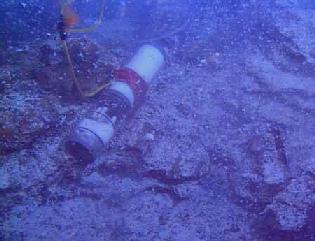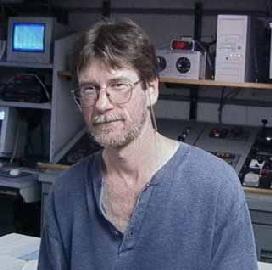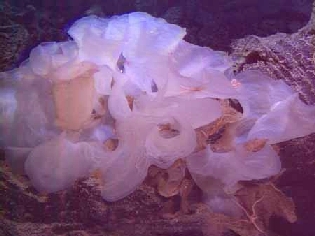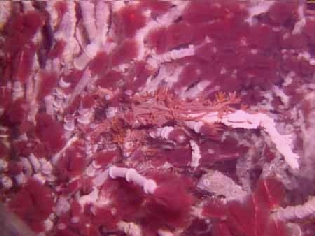WHAT'S NEW:
BACKGROUND:
Mission
Project Description
Cruise Plans:
Participants
Technology (ROV, ships, etc.)
Future Plans
Results:
1998 NeMO Cruise
Axial 1998 "Eruption"
Logbook
July 9, 1999
July 9, 1999
Contents:
- News from Thompson
- Participant Perspective
- Logbook from Teacher at Sea
- Question/Answer from shore to sea
Thompson Science Report
Science Report - Friday, July 9
Ships Location: 45 56.1/129 58.9
 Deployment of the osmosampler at Magnesia Vent. |
Listing of all Science News postings
Life at Sea: Participant Perspective
Kim Wallace
Canadian Scientific Submersible Facility
 Its three in the
morning. I could see my breath if it wasn't raining so hard and the wind
makes a misery of working under a tarp stretched over the cage. Fluid-4
and salt spray is keeping my hair in place. Im wet, tired and I'm grinning;
our ride is ready . However it may look from behind the yellow line, this
is the fun part.
Its three in the
morning. I could see my breath if it wasn't raining so hard and the wind
makes a misery of working under a tarp stretched over the cage. Fluid-4
and salt spray is keeping my hair in place. Im wet, tired and I'm grinning;
our ride is ready . However it may look from behind the yellow line, this
is the fun part.
For the ROPOS guys taking this puppy to sea is the tangible expression of our ever-expanding technical aspirations. Here at Axial we have the opportunity to test our mettle, and that of the machine we have put together, against some of the most intense environmental stresses imaginable: on the hearth of a blast furnace at the bottom of the ocean. Most of the time we win.
Notice I can't say much without saying we. That's another reality out here. We are a team as close as any family. We are here to operate and service the vehicle, twenty four hours a day, for a month. Can you name six people that you could live and work with for that long without going crazy?
On the beach were dealing with budgets, schedules, suppliers, customs and, on a good day, design problems. At sea we leave a lot of that behind. This is where it all comes together. Its a little intense and a lot rewarding.
This is the fun part.
Listing of all Perspectives postings
Teacher At Sea Logbook
Teacher Log #19 7/9/99
 Animal seen at CASM vent; most likely a sponge. |
The organisms that are most common to all vent sites are the various forms of microbes, bacteria and archaea. Fluid samples of the vents and suction samples of the surface show an abundance of these microorganisms. The macrofauna (larger animals) are the most visible of the hydrothermal vent ecosystems. Each vent with its own peculiar chemical signature and temperature, creates an environment for specific creatures. Any vent site may have any number of smaller communities each with its own diversity of organisms.
 Palm worms overlaying tube worms; palm worms behave agressively towards each other. |
Carnivorous species also exist here but are found in smaller numbers. Within the tube worm bushes, crawling about on open surfaces and even swimming, scale worms, centipede like creature with scales on their backs can be found in large numbers (some species are grazers as well). Nereid worms are not as commonly seen, but make up an important link in the transference of nutrient energy. Crabs and octopi can also be seen here searching for a meal, as can vent fish and the ever common rattail fish.
The most unique of the organisms at hydrothermal vents are the tube worms. These creatures, which have no mouth or anus, are known to have large numbers of bacteria within their tissues. This unique relationship (symbiosis) is believed to benefit both organisms - bacteria get a suitable environment to live and the worm takes advantage of the chemosynthetic properties of the bacteria for it nutrients. The most noticeable part of the tube worms are the bright red gill plumes that extend from the tops of their tubes. This gill plume is believed to absorb the vent fluid, which is then spread throughout the body of the organism, thereby feeding the bacteria.
The end of our cruise is quickly approaching. ROPOS is on the way to the bottom for its 500th dive! Will update you on its results tomorrow.
Bye for now.
Logbook of all Teacher At Sea postings
Questions & Answers
Questions from HMSC auditorium audience:
1) Have any dna studies been done on the sea floor critters to see how much their dna has diverged from sea surface critters? That is, do we have any idea where they fit into the ancestry chain?
Comparison studies looking at the ancestry chain have not necessarily been done using DNA but rather from fossils. It appears that most seafloor critters are newer than sea surface critters - that is that the modern sea fauna came from above.
2) Are any precious metals turning up in the rocks?
(Also see information in the
7/5/99 Perspective)
The 1998 lava flow is made of a volcanic rock called basalt. Generally,
there are no precious metals in basalt, although one of the minerals in
basalt is olivine, which is called peridot when it is gem-quality. This
is rare however (there is no peridot at Axial volcano). On the other
hand, there are precious metals in the sulfide chimneys that form at
hydrothermal vents. When seawater circulates down into the ocean crust
and gets heated up in volcanic areas, the heated water leaches out many
elements from the rocks and these get concentrated in the vent fluids.
Where the hot water exits the seafloor and mixes with the cold bottom
water, it immediately cools and precipitates minerals which build a
sulfide chimney around the vent orifice. Elements such as zinc, copper,
platinum, silver, and gold can be concentrated in hydrothermal sulfide
deposits. It is unlikely that it will ever be economical to mine
hydrothermal deposits on the seafloor, but there are many mineral deposits
presently mined on land that were formed long ago on the seafloor. In
fact, the study of the active ore-forming processes at hydrothermal vents
has helped geologist better understand how these ancient deposits
originally formed.
All Questions/Answers from sea
![]() Send Your Question to NeMO
Send Your Question to NeMO
(oar.pmel.vents.webmaster@noaa.gov)